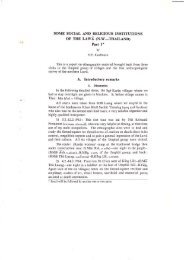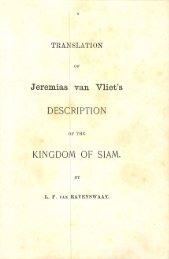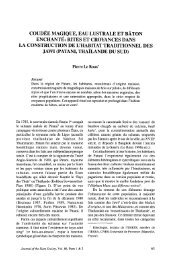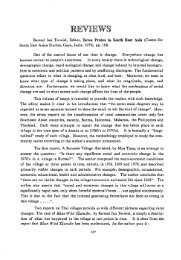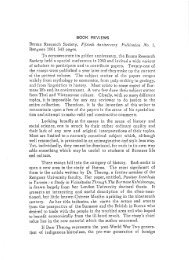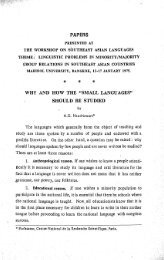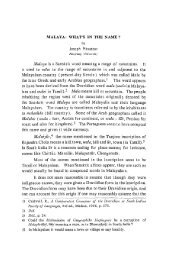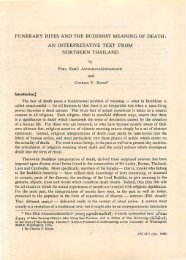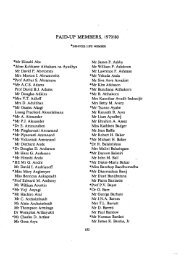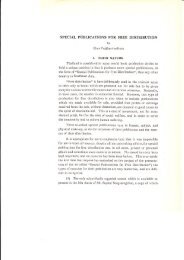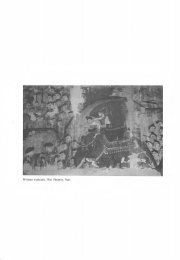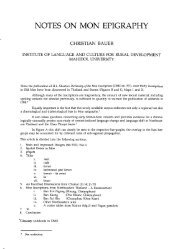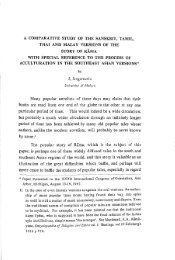JSS_073_0p_AyeKaw_Pu.. - Siamese Heritage Protection Program
JSS_073_0p_AyeKaw_Pu.. - Siamese Heritage Protection Program
JSS_073_0p_AyeKaw_Pu.. - Siamese Heritage Protection Program
Create successful ePaper yourself
Turn your PDF publications into a flip-book with our unique Google optimized e-Paper software.
236<br />
Aye Kyaw<br />
Thailand in general and will hopefully evoke interest from among both Burmese<br />
and Thai scholars.<br />
As a matter of fact the Lao Na Thai states were related to the Shan<br />
States and Sip Song Panna in the north, the states of Lao in the east, Sukhothai,<br />
Ayutthaya and Bangkok in the south and Burma in the west. In the course of<br />
their history, therefore, the Lao Na Thai states were a nerve centre, important<br />
both politically and culturally. The structure and dynamics of Lao Na Thai social<br />
and political life must be understood in terms of the traditional society which<br />
had been passed and by-passed through by different traits of political swings as<br />
well as by the diverse characteristics of cultural blends, out of which. modern<br />
Lao Na Thai or Northern Thailand emerged and the particular manner in which<br />
the transition to modernity developed.<br />
In studying Burmese and Thai documents, one is often confused by the<br />
spellings of certain terms or the names of certain places. To mention a few for<br />
instance, in the Burmese chronicles, Sukhothai is spelled as Thaukkate, Kamphaeng<br />
Phet as Kamapeik and Phisanulok as Pitthalauk. In the same way, Thai spellings<br />
for Atwinwun (Secretary of the Burmese Hluttaw) and for Athiwun (Chief of<br />
a group of people called athi) are not clear. This difficulty can be overcome only<br />
when we are able to check both Burmese and Thai chronicles.<br />
As regards the region of Sip Song Panna, there is only one M.A: thesis<br />
in English written by a Shan scholar in Burma - U Sai Sam Tip from Kengtung.<br />
His thesis - "The Lu in Sip Song Panna From the Earliest Times Down to A.D.<br />
1644"2 which exploits both Burmese and Chinese documents besides local chronicle<br />
of the Lu, is one of the best amongst the M.A. theses in Burma. His knowledge<br />
of Chinese and the invaluable assistance rendered by U Yi Sein, the Chinese<br />
expert at the Burma Historical Commission make his thesis a unique contribution<br />
to. the history of Burma as well as to the history of the Lao Na Thai states.<br />
In fact the region of Sip Song Panna, variously known in Burmese sources as Lu<br />
say nhac panna, Lu say nhac mre or Lu say nhac panna mre. It seems, however,<br />
that the Burmese names, the connotations of which are equated with the Thai<br />
name, Sip Song Panria the twelve districts or regions - centering at Chiang<br />
Rung or Keng Hung as its chief town, first appear in the Jambudipa u sonkyam<br />
(Leading Treatise on the Zambudipa). 3<br />
2. M.A. Thesis, Department of History, Arts and Science University, Rangoon, 1976.<br />
3. J.S. Furnivall, ed., Rangoon, Burma Research Society, 1960.
237<br />
Burmese Sources for Lan Na Thai History<br />
The twelve Pannas or the Sip Song Panna, as mentioned in the local<br />
history of the Lu comprise : (1) The region of Chiang Rung (Keng Hung) and<br />
Mong Ham; (2) The region of Mong Se, Chiang Lu and Mong Ong; (3) The<br />
region of Mong Long; (4) The region of Mong Hun and Mong Pan; (5) The<br />
region of Chiang-cheng, Mong Hai and Mong Ngat; (6) The region of Chianglaw<br />
(Keng-law) Mong Mang, Mong Ngam, Mong Hkang and Lang Nhe; (7) The region<br />
of Mong La and Mong Bang; (8) The region of Mong Hing (p'u-t' eng) and<br />
Mong Pang; (9) The region of Mong La (Ssu-mao) and Mong Wang; (10) The<br />
region of Mong :Hpaung, Mong Mang and Mong Yun; (11) The region of Mong<br />
Hu No and Mong Hu Haii- and (12) The region of Kengtung, Po-La and I-wu.4<br />
The importance of these regions especially the township of Chiang Rung was<br />
testified to by the visits of two foreign missions in the early colonial period to<br />
Chiang Rung - one led by Lt. MacLeod in 1837 and the other by a French<br />
Commission in 1868. 5<br />
Coming down from the township of Chiang Rung to the south, we find the •<br />
Shan States, known under British rule after 1922 as the Federated Shan States. The<br />
conception of the Shan States, of course, with the demarcated boundaries as it is<br />
now, perhaps emerged after the annexation of Burma by the British in 1886. Before<br />
that time, the Shan States was a conglomerate of different states with classical names.<br />
And in Burmese tradition there were nine Cis-SalweenShan States and nine Trans<br />
Salween Yuan States. In 1791 King Bodawpaya (1782-1819) sent Buddhist missions,<br />
each with one set of the Tripitaka to forty-two towns. In his royal order, this region<br />
is simply mentioned as Shan Pye (Pye = state), Yuan Pye, Lyan Pye and Linzin<br />
Pye. 6<br />
As a matter of fact the Shan States is dominated by various ethnic groups.<br />
4. Sai Sam Tip, pp. xxv-vi; according to Lt. H. Daly the twelve Pannas are :- Seven west of the<br />
Mekong- (1) Mong Long, (2) Mong Se, (3) Mong Hun and Mong Pan, (4) Keng Law,<br />
Mong Mang, Mong Lang Neu, Mong Khang, (5) Keng Seung, Mong Hai, Mong Ngat, Mong Yang,<br />
Mong Khawm and Mong Wi, (6) Mong Hpong, Mong Yan, Mong Man, (7) Chieng Hung, Mong<br />
Ham, Mong Nun; five east of the Mekong - (1) Mong La and Mong Wang, (2) Mong Heng and<br />
Mong Pang, (3) Mong Keng Tawng and Mong Nawng Teu, (4) . Mong Ou Neu and Mong Ou Teau,<br />
(5) Mong La and Mong Num Man. Major R. Fulton, Report and Notes on the Country Traversed<br />
by the Kyaington-Chieng Mai Mission in 1890-91, Simla, The Govt. Central Printing Office,<br />
1893, p. 78.<br />
5. Major R. Fulton, p. 78.<br />
6. Moung Htaung (Thathanabaing), Ametoau Aphre (Answers to the Royal Questions), Mandalay,<br />
Padetha Pitaka Press, 1961, pp. 457-59.
238<br />
AyeKyaw<br />
They are politically less sensitive, culturally diverse, ethnically numerous and linguistically<br />
affiliated or different, national groups in the Shan States. Many Shans believe<br />
the origin of the name Shan to be derived from Asama (unrivalled), a name given to<br />
the Thai invaders by the natives of Old Assam. 7 Besides the Shans living the length<br />
and width of the Shan States, there are other groups in the northern part, inter alia,<br />
Palaung, Kachin, Mingtha, Lisu, Myaungzu, Wa and Lahu; in the central part,<br />
Pa-o, Taung-yoe and Danu and in the southern part Intha, Danu, Taung-yoe, Pa-o,<br />
Padaung, Mussay, Yin-net, Yin-kya and Burmans. For the study of these ethnic<br />
groups, U Min Naing,.s Tui Tuin Ran Bwa: Pranthoncusa: (Our Indigenous Peoples<br />
of the Union) 8 and Bulma Socialist <strong>Program</strong> Party's Pranthoncu Mranma Nuinnam<br />
Tuinransa: Yankyemhu Rora Dhale Thumcammya: (Shan) (Traditional Customs<br />
and Cultures of the Peoples of the Union of Burma, The Shan) 9 are important.<br />
In the colonial period, the Shan Stateswas not only divided itself into different<br />
states but also separated from Burma Proper. The eventual reign of peace arid order<br />
after the annexation of the Shan States by the British stabilized the foundation of the<br />
Sawbwas whose families, relatives and officials enjoyed a greater share of profits<br />
derived from the British rule. "Certainly the star of feudalism shone brighter during<br />
the colonial rule," ·said a Shan scholar. 10 But the common peoples- poor peasants,<br />
cultivators, traders and artisans nevertheless were generally poor, although a few<br />
from among them, who knew how to butter their bread better, became better off.<br />
In this context, Daw Saw Khin Gyi portrays in her thesis- "History of the Cis<br />
Salween Shan States (1886-1900)" 11 -how the British maintained the upper echelon<br />
of the natives - the Sawbwas, while the common peoples thus were subject to<br />
changeless change. Contrarily, Sao Saimong Mangrai depicts in his book- The Shan<br />
States and the British Annexation 12 -how the British made the ruling class happier<br />
than ever before. These two works by Shan scholars are re-enforced by another<br />
Shan scholar's thesis - U Ba Thann Win : Administration of Shan States from the<br />
Panglong Conference to the Cessation of the Powers of the Saophas, 1949-1959," 13<br />
7. Sai Sam Tip, p. xxiv.<br />
8. Burma, Ministry of Union Culture, 1959.<br />
9. Burma Socialist <strong>Program</strong> Party, 1968.<br />
10. Saw Khin Gyi, "History of the Cis-Salween Shan States (1886-1900)", M.A. Thesis, Arts and<br />
Science University, Mandalay, 1973, p. 68.<br />
11. ibid.,<br />
12. Data Paper 52, Southeast Asia <strong>Program</strong>, Cornell University, Ithaca, New York, August 1965.<br />
13. M.A. Thesis, Arts and Science University, Rangoon, n.d.
239<br />
Burmese Sources for Lan Na Thai History<br />
providing a better understanding of the post-independence period of the Shan States.<br />
In fact Kengt\ing was the largest and Kyong the smallest of the Shan States.<br />
Kengtung situated on the Kengtung plains in between two great rivers - the Salween<br />
and the Mekong as well as being halfway between Chiang Rung and Chiang Mai<br />
was regarded in Burmese tradition as alan u kin (flag and watchpost) and is inhabited<br />
mostly by two Thai sub-groups - the Khun and the Lu - both closely related to<br />
the northern Thai. Kengtung, therefore, was important strategically to both Burma<br />
and China as Chiang Mai was to both Burma and Thailand. Economically Kengtung<br />
was a link of no less importance in a network of overland trade routes. These spread<br />
from the mouth of the Salween where Martaban was one of the most important<br />
seaports in the Mon Kingdom of Lower Burma, to the full length of the middle<br />
reaches of the Mekong into Yunnan. Important as it was, the history of Kengtung<br />
was inseparable from Burma and Lan Na Thai and, in this regard, Professor Dr<br />
Than Tun's Nay Lhai Rajawan (Travelogue) Vol. 1 14 and Sao Saimong Mangrai's<br />
The Padaeng Chronicle and the Jengtung State Chronicle Translatetl 5 are equally<br />
important.<br />
Regarding Buddhism in the Lan Na Thai states, there are two important<br />
works- Maha Dhamma Thingyan's Sasanalankara Catan and Mede Sayadaw's<br />
Vamsadipani (History of Theravada Lineages). 16 The author of the former was a<br />
Buddhist patriarch in Burma as well as an official after he was forced to leave<br />
monkhood during the reign of King Bodawpaya. The S'asanalankara Catan is one<br />
of his more than fifty works. His fame as the most learned patriarch and his life as<br />
a lay official together make the Sasanalankara Catan an authoritive history of<br />
Buddhism in Burma then. And as has been briefly indicated, the aerial journey made<br />
by the Buddha to the region of Yonaka, according to the Sasanalankara Catan,<br />
was the first and also the earliest phase in the spread of Buddhism to Lan Na Thai.<br />
Buddhist missionaries were sent at the conclusion of the Third Buddhist<br />
Council in the 17th year of King Asoka's reign (246 B.C.). According to the Sasanalankara<br />
Catan, Maharakkhitathera together with five senior monks was sent to the<br />
country of Yonaka, which has been identified by some as the Lan Na Thai states.<br />
The author, drawing heavily from the canonical evidence, argues that the country<br />
of Yonaka included not only Haribunja tuin but the Shan States as well, as it is<br />
14. Rangoon, Natha Taik, 1968.<br />
1S. Michigan Papers on South and Southeast Asia, The University of Michigan, Number 19, 1981.<br />
16, Rangoon, Hanthawaddy Press, 1966.
240<br />
Aye Kyaw<br />
mentioned in the Parajikam Athakatha not as " Maharakkhitatheram yonakaratham,"<br />
but as "Maharakkhitatheram yonakalokam." Although there are different opinions<br />
concerning the location of this country, the works, to mention a few for instance,<br />
such as the Sankhya Pakasaka Original by Zimmay(Chiang Mai) Shin Nyanawilasa,<br />
the Sankhya Pakasakadika by Siri Mingala Saya and the Visuddhi Magga Dipani<br />
by Zimmay Than Nyunt Kyaung Shin Ottamaradha are worth noting.<br />
The Vamsadipani is more interesting, and by its own raison d'etre it is a<br />
sine qua non for the study of Buddhist sects in Burma and to some extent for those<br />
ih Thailand. The vast territories taken by Tabinshwehti (1531- 50) and Bayinnaung<br />
(1551-81) (Burengnong in Thai) were, among others, the main causes for the proliferation<br />
of sects in both Burma and Thailand. During this period there was a close<br />
relationship between Burma and Thailand and travel on the overland routes encountered<br />
less difficulty. Those who traded between the two countries or those who wanted to<br />
study either in Burma or in Thailand did not insulate themselves from the dissemination<br />
of knowledge or of new ideas within Burmese and Thai societies. Many Thai<br />
monks studied Buddhist scriptures at the capital of Burma - Hanthawaddy - as<br />
it was the centre of learning then. According to the Vamsadipani, a sect - Rancanguim<br />
- originally founded in Thailand spread into Burma.<br />
As a matter of fact Buddhism originated in India, spread out dove- taillike<br />
to Ceylon and Southeast Asia. Native elites demonstrate in their Pali- oriented or<br />
vernacular works that the native kingdom, whether it be Pagan, Chiang Mai or<br />
Ayutthaya, was linked with the original home of Buddhist tradition and an established<br />
continuity, thereby, of the growth and spread of Buddhism in their respective kingdom<br />
was advocated. With such a raison d'etre both the Burmese and the Thai were not<br />
hesitant to see themselves as part of the larger world of Buddhism. In this context,<br />
the primary concern that the Buddha made aerial sojourns to some places in Burma<br />
Proper, Kengtung, Hariphunchai and Ayutthaya, was a source of pride and prestige,<br />
conformable with the notion that "native" Buddhism introduced by the Buddha<br />
Himself when He was alive was " pure" par excellence in content and greater in<br />
character. Buddhism, thus, was bound to take root in the kingdoms in Burma and<br />
Thailand.<br />
With such indigenous justification of how the seeds of "pure" Buddhism<br />
were sown in the native kingdoms, the Sasanalankiira Catan and the Vamsadipani
241<br />
Burmese Sources for Lan Na Thai History<br />
are comparable with LanNa Thai local works 17 such as the Jinakalamalipakaranam<br />
(Sheaf of Garlands of the Epochs of the Conqueror) 18 by Phra Ratanapanna of<br />
Chiang Mai, the Tamnan Mun/asatsana (History of the Origin of the Religion) 19<br />
by Phra Phutthaphunkam and Phra P hutthayan and the Camadevivamsa (History<br />
of Camadevi) 20 by Phra Bodhiransi of Chiang Mai. The non-local works such as<br />
the Phongsawadan Nua (Chronicle of the North) 21 by Phra Wichianpricha (Noi)<br />
and the Phongsawadan Yonok (History of the North) 22 by Phraya Prachakit Korachak<br />
(Chaem Bunnag) re-enforced the former works in reconstructing the history of<br />
early Buddhism in the Lan Na Thai states.<br />
As regards Burma's relations with Thailand, there are two important theses :<br />
U San Nyein's "Yodaya Mranma Saksamre Samuin, 1500-1700 (History of Thai<br />
Burmese Relations, 1500-1700) 23 covering 200 years of Thai-Burmese relations<br />
and U Kyaw Win's "Tonnu Khat Mranma Nuinnam Samuin, 1500-1600 (History of<br />
the Toungoo Dynasty 1500-1600). 24 In addition to these works, U Aung Thein<br />
(His Thai name is Luang Phraison Salarak) who lived in Thailand for many years,<br />
translated Prince l)amrong's Thai Rop Phama (Thai-Burmese Wars) 25 into English.<br />
His works were published in the Journal of the Burma Research Society and the<br />
17. For an analysis of early LanNa Thai Historiography, see Anan Ganjanapan, "Early LanNa Thai<br />
Historiography: An Analysis of the Fifteenth and Sixteenth Century Chronicles," M.A. Thesis,<br />
Cornell University, January 1976.<br />
18. Written in 1516-17 in Pali. The first translation into the Thai language was made in 1794 by the<br />
order of Ki ng Rama I. It was first published in 1908 and later was translated into French by George<br />
Coedes, who published it in the Bulletin de /'Ecole Francaise d'Extreme Orient, tome xxv (1925).<br />
A new Thai version by Saeng Monwithun was first published in 1958. In 1960 a romanized edition<br />
was published by the Pali Text Society in London. Finall y, in 1968 the English translation by N.A.<br />
Jayawickrama was published under the title of The Sheaf of Garlands of the Epochs of the Conqueror:<br />
being a translation of Jinakalamalipakaranam of Ratanaphanna Thera.<br />
19. Written in the 1420s in the Thai Yuan Language. It was translated into central Thai and first<br />
published in 1939.<br />
20. Written in c. 1570 in Pali. It was first translated into modern Thai and published in Bangkok in 1920.<br />
21. Written in 1807. Krom Sinlapakon, Prachum phongsawadan phak !hi I (Collected Chronicles,<br />
Part I), Bangkok, 1956. A French translation by C. Notton is published as Legendes sur le Siam<br />
erie Cambodge, Bangkok, 1939.<br />
22. Written in 1906 in a very scholarly way. Bangkok, 1955.<br />
23. M.A. Thesis, Arts and Science University, Mandalay, 1968.<br />
24. M.A. Thesis, Arts and Science University, Rangoon, 1970.<br />
25. Bangkok, Klang Withaya, 1962.
242<br />
AyeKyaw<br />
relevant portions from the Mhannan Rajawantoaukri (The Glass Palace Chronicle)<br />
under the title of " Intercourse between Burma and Siam, as recorded in Hmannan<br />
Yazawindawgyi" were published in the Journal of the Siam Society. The last part<br />
of the Thai Rop Phama however still remains untranslated into English.<br />
The relationships between Burma and Thailand became very important with<br />
the rise of the Toungoo dynasty. After the fall of Pagan in 1287, Burma was characterised<br />
by internal wars between different petty states. It was only with the rise of<br />
the Toungoo dynasty that all the petty states were integrated into a· vast kingdom<br />
which not only touched Arakan in the west but comprised the Lan Na Thai states,<br />
some of the Lao states in the east and for a while, Ayutthaya as well. The location<br />
of Toungoo, though the same latitude as Prome, enjoyed· a happier position than<br />
Prome. Toungoo, away and free from the war-torn routes, had good time to gather<br />
strength for its future development as the most important city in the valley of the<br />
Sittang. In addition, Toungoo is almost halfway between the Irrawaddy Delta and<br />
Upper Burma and close as well to the Kyaukse irrigation area. Favoured by these<br />
conditions and unlike any other towns on the direct route between Ava and the<br />
Delta which were generally either to be conquerors or to be conquered, Toungoo<br />
eventually became a haven of refuge for those who ran away from the war-frequented<br />
towns.<br />
In the olden days, the crucial twin factors of control of land and manpower<br />
were the sine qua non for any one, either from among blood royal or from among<br />
commoners, to grip political power. In this context, the growing population at and<br />
in the neighbourhood of Toungoo, the charismatic ruler, Minkyinyo (1486-1531),<br />
and Toungoo's acquisition of land such as the Kyaukse region were the main causes<br />
for Toungoo's rise to power. The real turning point, of course, in the history of<br />
Toungoo took place when Minkyinyo founded the Toungoo dynasty in 1510. In this<br />
regard, there are two useful works- Professor U Chan Mya's Tonnu Rajawan<br />
Akyinkhup nhan Rhwe Samtoau Bhura:samuin (A Concise History of Toungoo<br />
and History of the Shwe San Daw Pagoda) 26 and Lecturer U Sein Lwin Lay's Montara:<br />
Rhwethi nhan Bhurannon Ketumati Tonnu Rajawan Aca Acum (A Complete History<br />
of Toungoo ) 27 The latter is more comprehensive than the former.<br />
Toungoo was so great and so vast that the Thai expression - Nung thi<br />
26. Toungoo, Zeya Press, 1%1.<br />
27. Rangoon, Sepanthaya Press, 1968.
243<br />
Burmese Sources for Lan Na Thai History<br />
Toungoo (The one at Toungoo)- is quite fitting when referred to a person who<br />
was the greatest genius. This idiomatic expression, though is hardly known in Burma.<br />
Ya Khop's eight volume work- Phu Chana Sip Thit (Conqueror of the Ten Directions)28<br />
- is one of the longest historical novels in Southeast Asia and deals with<br />
Bayinnaung. This novel, because of its fine plot and its high literary standard, is<br />
well known in Thailand but is less known in Burma. Its popularity was reenforced<br />
by a film and some popular songs about Bayinnaung. There is no comparable<br />
Burmese novel in Burma but U Thein Maung's Bhurannon Atthuppatti (Biography<br />
of Bayinnaung) 29 is useful for research on Bayinnaung. And Ledi Pandita U Maung<br />
Gyi's four volume historical novel- Tapinrhwethi (On Tabinshwehti)30 which<br />
has no Thai counterpart; is of importance to the study of the Toungoo dynasty.<br />
It will be of interest here to give a short account on Bayinnaung whose life<br />
was indeed, as Harvey puts it, "the greatest explosion of human energy ever seen<br />
in Burma. " 31 Bayinnaung was the son of a toddy-climber at Ngathayuak, a village<br />
in the Pagan township. He was named Maung Cha Tat because, during the early<br />
days of his birth, a number of white ants swarmed around him. His parents migrated<br />
south to Taungdwingyi. One day while his father was climbing a toddy tree in order<br />
to tap its juice, the mother laid the infant on the ground and went elsewhere. In her<br />
absence, a big serpent coiled itself around the child without doing any harm to<br />
him. On the return of his mother to the child, the reptile gently glided away. His<br />
parents consulted with a learned monk regarding the unusual omen. He asked them<br />
to go to Toungoo where the child would possess greatness and prosperity. As instructed<br />
by the monk, they went to Toungoo where they stayed at a monastery the abbot of<br />
which happened to be preceptor of King Minkyinyo. It was through the influence of<br />
the monk that Maung Cha Tat's mother got a job at the palace and, accordingly,<br />
Maung Cha Tat grew up at the palace with the son and daughter of the reigning<br />
king. He got married to the princess and eventually became one of the greatest figures<br />
in Burmese history even though he had not a drop of royal blood in his veins.<br />
In his vast kingdom, Bayinnaung introduced a standardized monetary system,<br />
standardized weights and measurements and standardized taxation. Notably also, he<br />
forbade all animal sacrifices yearly performed in honour of the Mahagiri Nat at<br />
28. Bangkok, Amonkanphim, 1971.<br />
29. Rangoon, Burma Yokshin Press, 1933.<br />
30. Rangoon, Kayathukha Press, n.d.; second edition, Rangoon, Sittamon Sape, 1971.<br />
31. Cited in D.G.E. Hall, Burma, London, Hutchinson's University Library, 1956, p. 42.
244<br />
Aye Kyaw<br />
Mount Popa by those who lived at Pagan, Ywatha, Pakhan Nge, Nga Thayuak,<br />
Tuywin Taing and Kyaukpadaung. After the yearly animal sacrifices, the heads of<br />
the sacrificed buffaloes, cows, pigs and chickens were tied up with ropes and<br />
hung up at the front posts of the houses. In addition to this, he also forbade Shan<br />
funeral sacrifices in which, if a Shan Sawbwa passed away, his elephants and horses<br />
and his nearest and dearest including his slaves were forced to be burnt or buried<br />
together with their Sawbwa.<br />
During this period, the art of horsemanship was popular with members of<br />
the royal family. There was a game known in Burmese as kulikaca:ne play among<br />
men riding horses. Among the women dice play was a popular indoor game. Tattooing<br />
among the men was important as they regarded it as essential to have a manly appearance<br />
and courage. One Burmese source mentions that a girl asked her lover to have<br />
his thighs "blackened" before they got married. And an oral tradition has it that<br />
tattooing was usually undertaken at the monastery. One's horoscopic destiny was<br />
calculated to be harmonious with the astronomical time and space and after having<br />
been tattooed the person thus tattooed had to lie down on banana leaves for about<br />
five days. In addition to tattooing, occultism and magic were very popular among<br />
the people. Also in literature the Sukhothai, Lan Na Thai and Shan scripts were<br />
actively encouraged to develop.<br />
It was during this period that a young Thai prince by the name of Naresuan<br />
was forced to live at the Burmese Court for more than fifteen years. He learnt<br />
Burmese and perhaps Mon too and became well versed in the art of Burmese warfare.<br />
Apart from this, did he fall in love with "a beautiful skinned, Indian-eyed<br />
Burmese princess with long smooth hair," after living there for such a long period ?<br />
The answer is unclear. However, a young Burmese prince known .as Nat Shin Naung,<br />
son of the founder of Toungoo, fell in love with the younger sister of the king of<br />
Chiang Mai. The princess, called Dhatukalaya, was so beautiful that, according to<br />
his poems, she was the only one who owned all fine characteristics of beauty. Perhaps<br />
there would be some oral traditions about her either in the Lan Na Thai states or at<br />
the capital of Burma. A student of Burmese literature cannot ignore the excellence,<br />
beauty and importance of Nat Shin Naung's poems. For the study of the biographies<br />
of poets and men of letters who were involved in wars and administration of such<br />
a vast kingdom, there are two important works- U Pe Maung Tin's Mranma Cape<br />
Samuin (History of Burmese Literature) 32 and Captain Ba Thoung's Casotoaumya:<br />
32. Rangoon, Aungse Sape Taik, 1971.
Atthupatti (Biographies of Poets). 33<br />
245<br />
Burmese Sources for Lan Na Thai History<br />
To understand the system of Burmese administration, a student of Burmese<br />
history cannot avoid U Tin's five volume work- Mranma Man Aupkhuppum<br />
Catam (Treatise on Administration of Burmese King) 34 - which is as much important<br />
to the research of Burmese administration as Prince Damrong's works- Laksana<br />
Kanpokkhrong Prathet Sayam tae Boran (Ancient Administration of Siam)35 and<br />
Thesaphiban (On Provincial Government) 36 to that of Thai administration. U Tin's<br />
work is reliable and there is no comparable work in Burma. It contains many primary<br />
sources such as royal orders, although it is influenced by imperial ideas predominant<br />
in British policy towards Burma in the 1920s. U Tin was appointed government<br />
compiler in January 1921 and his assigned duty was to sort out the Burmese records<br />
and write the Mranma Man Aupkhuppum Catam. By virtue of his position and<br />
due to his knowledge of the Burmese government, he had access to some twenty<br />
thousand purapuik (folded books).<br />
His first volume deals with the concepts and foundation of Burmese kingship;<br />
the second is a continuation of the first in terms of discussing kingship and<br />
mentioning the social divisions of Burmese society and the demarcation of the<br />
provinces during the Pagan and Konbaung dynasties; the third one describes the<br />
social organization, particularly the amhutham (servicemen) and the institution of<br />
central statecraft; the fourth one narrates the duties and functions of the H/utyon<br />
Ngayat (Five Central Courts), the relationship among them, the provincial administration,<br />
the method of appointing the officials, the departments of religious affairs,<br />
army, judiciary and finance; the fifth one deals with the kinds of land, the salaries<br />
of officials, the department of public works and is appended by Bodawpaya's<br />
Rajasatkri Amintoau (Bodawpaya's Proclamation). In them also can be found some<br />
information regarding Lan Na Thai history and administration.<br />
One Burmese dictionary- U Maung Maung Tin's Rhwenansum Wohara<br />
Abhidhan (A Dictionary of Royal Usages) 37 is also an important source. It deals<br />
with words and phrases in use at the palace and also defines various posts in the<br />
royal service in 420 sections. In fact most of the sections are compilations of appoint-<br />
33. Rangoon, Shumawa Press, 1955.<br />
34. Rangoon, Central Press, Vol. I, 1963, Vol. II, 1965; Vol, III, 1970, Vols. IV and V, 1933.<br />
35. Bangkok, Rongphim Thanakhanomsin, 1959.<br />
36. Bangkok, Rong Ruang Tham, 1967.<br />
37. Rangoon, Buddha Sasana Council Press, 1975.
246<br />
AyeKyaw<br />
ment orders of officials; but some nevertheless provide information about the Thai<br />
musical groups at the Burmese Courts and the Chiang Mai cavalry. Thai songs<br />
(Yodaya: Sikhyan) and Thai dance (Yodaya: Aka) are well known in Burma and<br />
are interwoven with Burmese culture. 38 We have mentioned much about Burmese<br />
influence on Thai society but Thai influence upon Burmese society is also profound.<br />
There are many unpolished royal decrees housed in different libraries in<br />
Burma which have information on LanNa Thai history. Among the published royal<br />
orders, three works- Daw Khin Khin Sein's Alonmantara: Amintoau Mya: (Royal<br />
Decrees of Alaungpaya), 39 Thathanabaing Moung Htaung Sayadaw's Ametoau Aphre<br />
(Answers to the Royal Questions) and Taw Sein Ko's Hluttaw Mhattam (Records<br />
of the Hluttaw) 40 - are important. Daw Khin Khin Sein's work mainly deals with<br />
the royal orders, but Moung Htaung Sayadaw's work is a veritable encyclopedia of<br />
religion, astronomy, politics and court etiquette. Bodawpaya asked the Thathanabaing<br />
many varied and delicate questions and the Thathanabaing answered all of them<br />
with great erudition. The Hluttaw Mhattam (contains royal edicts, laws and regulations,<br />
instructions to Myothugyi (Town headman : Chao Muang in Thai) and Ywathugyi<br />
(Village headman: Phuyaiban in Thai), instructions to provincial governors, rules<br />
for levying tax, civil proceedings, judgements in civil suits, criminal proceedings,<br />
letters between the Hluttaw and the provincial governors, papers relating to the Shan .<br />
States, correspondence between the Burmese government and the Thathanabaing and<br />
memoranda. Some information concerning the Shan States, the Lan Na Thai states<br />
and Thailand in general can be found in these works.<br />
And the rajawan, identical with the phongsawadan, comes from two Pali<br />
words - raja and vamsa; the Thai term, also derived from two Pali words - bansa<br />
and avatara, conveys the same connotation as of the rajawan which means annals<br />
of members of a line, dynasty or kingdom. Therefore, the rajawan or the phongsawadan<br />
are generally dynastic chronicles. The oldest chronicle extant in Burma is the Rajawan<br />
Kyoau (The Celebrated Chronicle) 41 by Shin Thilawuntha, the great monk poet who<br />
lived in the fifteenth century. Perhaps the oldest phongsawadan in Thailand is the<br />
38. Burmese classical dance style is far closer to that of Siam than to that of India and a principal type<br />
Burmese classical song, the yodaya: takes its name from Ayutthaya. See U Khin Zaw, "Burmese<br />
Music, A Partnership in Melodic Patterns," Perspective of Burma, An Atlantic Monthly Supplement,<br />
1958, pp. 67-71.<br />
39. Rangoon, Burma Historical Commission, 1964.<br />
40. Rangoon, Govt. Press, 1960.<br />
41. Rangoon, Hanthawaddy Press, 1965.
247<br />
Burmese Sources for Lan Na Thai History<br />
Phraratchaphongsawadan Krung Si Ayudhya chabap Luang Prasoet (The Luang<br />
Prasoet Chronicle of Ayudhaya) 42 of the seventeenth century. Comparatively speaking,<br />
the gro.wth of this new type of history in Thailand occurred about two centuries<br />
later. As such, whether the new tradition in Thai historiography happened because<br />
of Burmese influence, which was high during the Toungoo dynasty, or due to the<br />
impact of Europeans who were present in Ayutthaya by then, is a matter for further<br />
research. In the Burmese case the presence of foreigners at Hanthawaddy had no<br />
effect on the concept and tradition of Burmese historiography.<br />
Last but not least are the Burmese chronicles. In Burmese there are four<br />
terms, important and related to history- thamaing (samuin), rajawan, mhattam<br />
and aretoaupum. In Thai too, there are four important terms - tamnan, phongsawadan,<br />
chotmaihet and prawatsat. The term, thamaing perhaps deriving from<br />
Pali, thamuti (samuti) is associated with the Buddha; hence with the Dhamma as<br />
well. It has two shades of meaning - one which can be equated with the Thai term -<br />
tamnan and the other with the term - prawatsat. The literature of the thamaing in<br />
Burma as with that of the tamnan in Thailand, forms a mine of curious information,<br />
legendary or authentic, on history. And as with the tamnan, the thamaing, generally<br />
governed by the religious nature of their contents, were mainly devoted to particular<br />
Buddhist monuments and incidentally include something about the doings of a<br />
king or kings. The use of thamaing as synonymous with prawatsat - a new modern<br />
term for history coined during the reign of King Rama VI (1910-25), was first used<br />
in Burma just before the second world war. The Burmese simply use an old term<br />
with new connotations whereas the Thai invented a new term to convey the same<br />
meaning.<br />
Besides the rajawan, the Burmese terms, mhattam 43 and aretoaupum 44 are<br />
synonymous with the Thai terms, chotmaihet or kotmaihet and they deal with account<br />
or report on particular events. In particular, the aretoaupum are concerned with the<br />
short histories of particular wars or uprisings. Be that as it may, as with the phongsawadan<br />
in Thailand, the rajawan are by far the most important in Burma. From<br />
among the rajawan, the Mhannan Rajawan is by no means unimportant. Professor<br />
42. Prachum phongsawadon phak thi I (Collec.ted Chronicles, part 1), Bangkok, 1956.<br />
43. See for example, U Chein, <strong>Pu</strong>take Capain Ita/yam Swa Mhattam, (Diary of the Mission to Portugal,<br />
Spain and Italy), Mandalay, Ludu Press, 1959; Pe Maung Tin, ed., Kinwun Mingyi London Swa<br />
Mhattam, (Kinwun Mingyi's London Diary), Rangoon, Govt. Printing and Stationary, 1953.<br />
44. See for example, Nai Pan Hla, ed., Rajadirit Aretoaupumkyam, (Account on Rajadirit War),<br />
Rangoon, Thein Than Oo Press, 1977.
248<br />
AyeKyaw<br />
G.H. Luce and Pe Maung Tin have translated parts, Ill, IV and V of the Mhannan<br />
Rajawan; this work - the Glass Palace Chronicle of the Burmese Kings, is generally<br />
known as the Glass Palace Chronicle. 4s As a matter of fact, the compilation of the<br />
official history of Burma from the earliest time to 1821 was ordered by Bagyidaw<br />
(1819-37) a coniemporary of Rama II (1809-24). A commission 46 was appointed<br />
for this purpose and it took three years to finish the work.<br />
This chronicle, known as the Mhannan Rajawan is of great importance but<br />
also of course an improvement on U Kala's Maharajawan (The Great Chronicle). 47<br />
To bring the official history up to date, King Mindon (1853-78), a contemporary of<br />
King Mongkut (1851-68) appointed a commission 48 in 1867. This commission compiled<br />
the Dutiya Mhannan (The Second Glass Palace Chronicle) 49 which goes down to<br />
the beginning of Mindon's reign, 1853. These two Mhannan Rajawan are reliable<br />
and thorough, for the commissions sifted through all the available Records then<br />
compiled the chronicles. The sponsors agreed on the guideline that "a chronicle of<br />
kings should be the standard, a balance, so to speak, for all duties of kings, for all<br />
affairs of state, for all matters of religion and not a thing of conflicting and false<br />
statements. ,so<br />
U Maung Maung Tin continued the Dutiya Mhannan until 1885 through<br />
the reigns of King Mindon and King Thibaw (1878-85). Then, combining the Mhannan<br />
Rajawan from the rise of Alaungpaya in 1752 to the end of Pagan's reign in 1853<br />
with his own work from 1853 to 1885, he published a chronicle named the Kunbhon<br />
Rajawantoaukri (The Konbaung Chronicle)s 1 which is also known as Kunbhonsat<br />
4S. First published in 1923 by Oxford University Press and reprinted in 1960 by the Burma Research<br />
Society.<br />
46. This commission comprised: (1) Monrwe Sayadaw Shin Adiccavamsa Adiccaransi, (2) Thawkapin<br />
Sayadaw, (3) Mahadhammasankran (ex-Moung Htaung Thathanabaing), (4) Myinsuwungyi<br />
U Rauk, (S) Thandawsint U Chein, (6) Sayedawgyi U Phyaw, (7) Bisikpunna Jeyadeva,<br />
(8) Bisikpunna Kumudra, (9) Byedaik Thansint U Rwe, (10) Saye U Lu Gyi, (11) Saye U Aung<br />
Tha, (12) Atwinwun Sawmyosa Mingyi Sirimahanandasankran and (13) Singumyosa Atwinwun<br />
Athiwun<br />
47. Rangoon, Hanthawaddy Press, Vols. I and II, 1960, Vol. III, 1961.<br />
48. This commission consisted of: (1) Kani Atwinwun Mingyi Mahamankhonsankhaya, (2) Khanmamanwun<br />
Muinkhuin Myosa Pitakataup Mahasirijeyasu, (3) Aimrhe Atwinwun Mahamanlhasankhaya,<br />
(4) Sayegyi Marilhajeyasu and (S) Sayetoaukhon Nemyocansuraja<br />
49. Mandalay, Mandalay Times Press, 1919.<br />
SO. The Glass Palace Ohronicle, ·p. ix
249<br />
Burmese Sources for Lan Na Thai History<br />
Maharajawantoaukri. As this chronicle covers the whole period of the Konbaung<br />
dynasty (1752-1885), it is of great importance to the study of both Thai and Burmes_e<br />
history. Comparatively speaking, the Kunbhonsat Maharajawantoaukri is as important<br />
to the study of the Konbaung dynasty as Thiphakorawong's Phraratchaphongsawadan<br />
Krung Rattanakosin (Royal Chronicle of the Bangkok Era) 52 and Prince<br />
Damrong's Phrarachaphongsawadan Krung Rattanakosin Ratchakan Thi 2 (Royal<br />
Chronicle of the Second Reign of the Bangkok Era) 53 to that of the Chakri dynasty.<br />
If we can use all mentioned Burmese documents for research on Lan Na<br />
Thai history, the result of that research, undertaken in the light of both Thai and<br />
Burmese sources, will be a unique contribution to the wealth of Thai studies.<br />
51. Mandalay, Mandalay Times Press, 1905; Reprinted in 1968 by Lede Mandaing Press, Rangoon.<br />
52. 5 Vols. Bangkok, Khrusapha, 1961.<br />
53. 2 Vols. Bangkok, Sigsaphannid, 1962.



